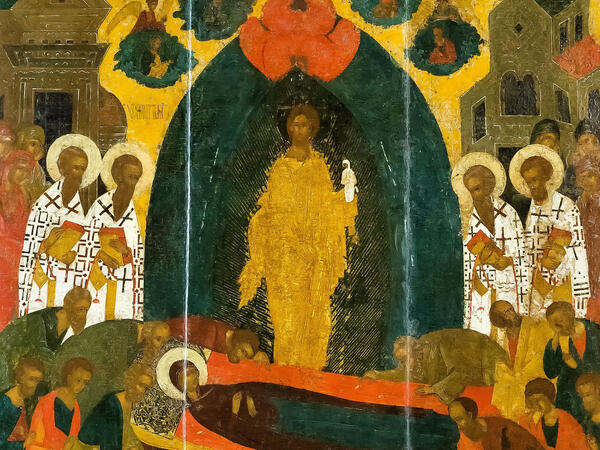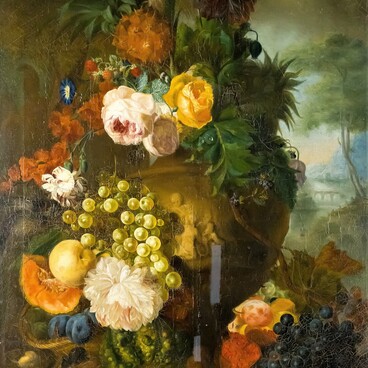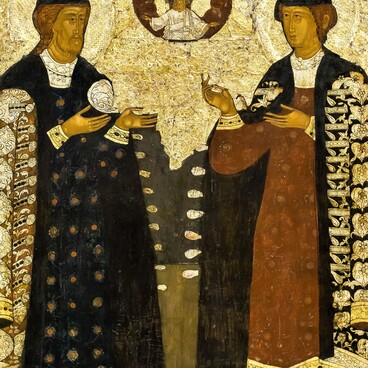The Dormition (Uspenie in Russian) is one of the twelve most important holy days. It is celebrated on August 28 (August 15 Old Style). The meaning of the word ‘Uspenie’ comes from the Old Russian and stands for ‘falling asleep’. The feast of the Dormition of Our Lady celebrates the Mother of God’s not being kept down by the bonds of death and her finding eternal life in God.
The description of the events that took place during the Dormition can be found in the Protoevangelium of James, the Legend of Pseudo-John the Apostle, and the Word of St. John of Damascus. They tell a story about the last three earthly days of the Blessed Virgin when the Mother of God returned from Ephesus to Jerusalem, where the Archangel Gabriel appeared to Her bringing the heavenly tidings about the Dormition. Through the prayer of the Mother of God, the angels miraculously summoned the apostles to Jerusalem from the places where they were preaching the Gospel.
In Byzantine, artists arranged the composition of the Dormition of the Virgin in two ways — either a simplified or an extended one. In the monumental painting of the Balkan countries, the composition consists of a detailed narrative associated with the Dormition of the Virgin. The Savior with the Infant in swaddling clothes — the soul of the Mother of God — is usually placed in the center. The apostles, saints and righteous wives are depicted on the sides, and at the top of the composition there are scenes of the miraculous arrival of the apostles, brought by the angels to Jerusalem, and the taking up of the Mother of God into Heaven. Such iconography is called “cloudy Dormition”.
According to church legend, the icons of the 16th century depict the saints — James of Jerusalem, Timothy of Ephesus, Hierotheos of Athens, and Dionysius the Areopagite — as the eyewitnesses to the event. In the earlier icons, artists used to portray two or three saints, as well as angels. The expanded version of the Dormition of the Virgin included one more scene with Avphonius, punished for his wicked act by the Archangel Michael.
In Old Russian art, the full version of the composition became popular in the second half of the 15th century.
The icon from the Assumption Cathedral of Sviyazhsk, presented in the exhibition, contains all the aforementioned elements of the Dormition composition. This work is distinct for the image of the Mother of God taken into Heaven, which is found in the few rare icons of the 16th century.
The description of the events that took place during the Dormition can be found in the Protoevangelium of James, the Legend of Pseudo-John the Apostle, and the Word of St. John of Damascus. They tell a story about the last three earthly days of the Blessed Virgin when the Mother of God returned from Ephesus to Jerusalem, where the Archangel Gabriel appeared to Her bringing the heavenly tidings about the Dormition. Through the prayer of the Mother of God, the angels miraculously summoned the apostles to Jerusalem from the places where they were preaching the Gospel.
In Byzantine, artists arranged the composition of the Dormition of the Virgin in two ways — either a simplified or an extended one. In the monumental painting of the Balkan countries, the composition consists of a detailed narrative associated with the Dormition of the Virgin. The Savior with the Infant in swaddling clothes — the soul of the Mother of God — is usually placed in the center. The apostles, saints and righteous wives are depicted on the sides, and at the top of the composition there are scenes of the miraculous arrival of the apostles, brought by the angels to Jerusalem, and the taking up of the Mother of God into Heaven. Such iconography is called “cloudy Dormition”.
According to church legend, the icons of the 16th century depict the saints — James of Jerusalem, Timothy of Ephesus, Hierotheos of Athens, and Dionysius the Areopagite — as the eyewitnesses to the event. In the earlier icons, artists used to portray two or three saints, as well as angels. The expanded version of the Dormition of the Virgin included one more scene with Avphonius, punished for his wicked act by the Archangel Michael.
In Old Russian art, the full version of the composition became popular in the second half of the 15th century.
The icon from the Assumption Cathedral of Sviyazhsk, presented in the exhibition, contains all the aforementioned elements of the Dormition composition. This work is distinct for the image of the Mother of God taken into Heaven, which is found in the few rare icons of the 16th century.



